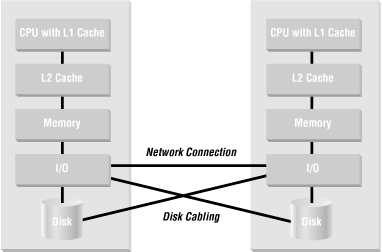Clusters
Clustered systems have provided a high-availability, high-scalability solution since the 1980s, initially via DEC’s VAXcluster. Clusters can combine all the components of separate machines, including CPUs, memory, and I/O subsystems, into a single hardware entity. However, clusters are typically built by using shared disks linked to multiple “nodes” (computer systems) as well as an interconnect between systems as a means of exchanging data and instructions without writing to disk (see Figure 11-3). Each system runs its own operating system copy and Oracle instance.

Figure 11-3. Typical cluster (two systems shown)
Oracle’s support for clusters dates back to the VAXcluster. Oracle provided a sophisticated locking model so that the multiple nodes could access the shared data on the disks. Clusters required such a locking model, because each machine in the cluster had to be aware of the data locks held by other, physically separate machines in the cluster.
Today, that Oracle solution has evolved into Real Application Clusters (formerly Oracle Parallel Server or OPS) and is most frequently used for Windows NT and Unix-based systems. Oracle provides an integrated lock manager used to manage concurrent access to the shared disk. Simply stated, the lock manager works like a traffic cop and provides control over ownership of data that can be accessed by more than one user from more ...
Get Oracle Essentials: Oracle9i, Oracle8i and Oracle8, Second Edition now with the O’Reilly learning platform.
O’Reilly members experience books, live events, courses curated by job role, and more from O’Reilly and nearly 200 top publishers.

